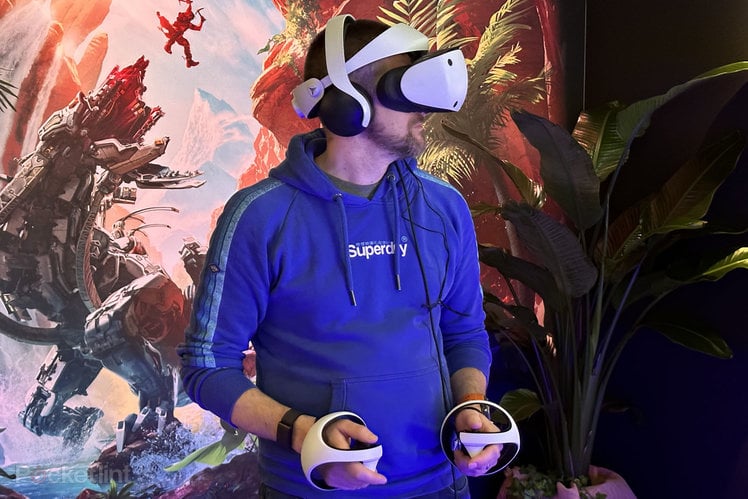
Sony is returning to virtual reality with the PSVR 2, a comprehensive rethinking of the VR headset originally launched on PlayStation in 2016.
With the next-gen headset launching on 22 February 2023 – and pre-orders already open – there are big changes coming down the line. Previewed for the first time in public at CES 2023, we were there to put it through its paces.
Design and build
The PlayStation VR2 is a designed to fit in with your PlayStation 5 and is exclusive to that console, connecting via a single USB-C cable.
The package is really divided into two parts, the headset and the Sense controllers. Starting with the headset, it’s split into the halo-style strap which supports the visor part of the package.
This design will be familiar as it’s similar to the original version, with the adjustable headstrap well-padded so it’s softly cushioned around your head. There’s a dial on the rear to tighten the headstrap for precise adjustments, while there are buttons on both the visor and the headstrap for quick release to make it quick and easy to put on or remove PSVR 2.
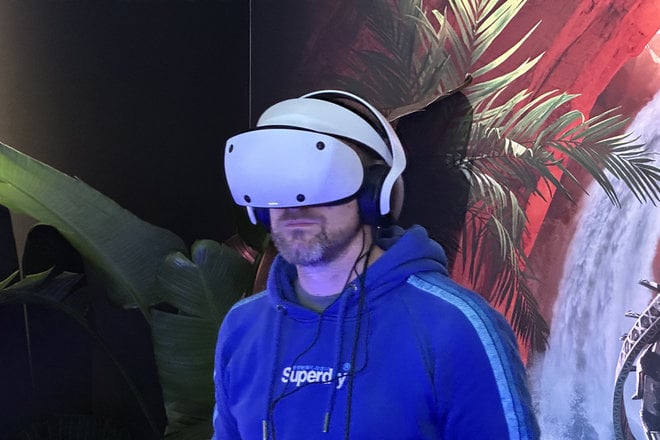
The great thing is you can just push the button to slide the visor away from your face if you need to break out into the real world quickly.
First impressions are of a headset that’s comfortable, nicely balanced, looks great – but is also easy to put on and get going. We also found it really effective at cutting out light leaks thanks to the padded cushion around the visor.
Headphones are supplied, but they are earbuds. For the purpose of this demo, we used the Sony Pulse 3D headphones, which actually match perfectly.
The Sense controllers offer wrist straps so you don’t have to worry about dropping them or throwing them if you get too enthusiastic, but they feel light enough to avoid fatigue, with a range of buttons falling into logical places.
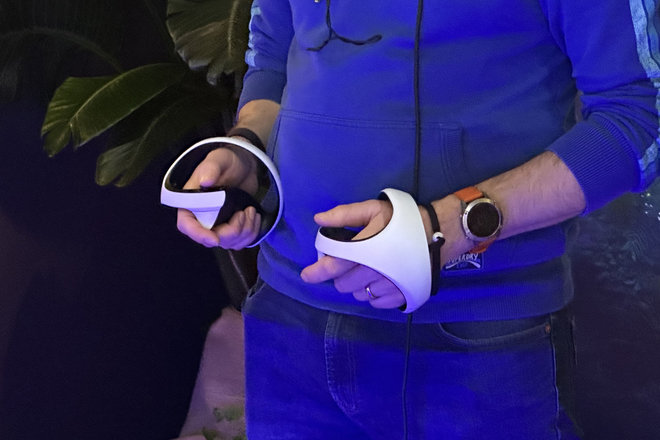
The design of VR hand controllers seem to all be heading in the same direction, but the Sense controllers are a little smarter than some as they’ll also detect your finger movements – which can contribute to games, or just allow you to make gestures or point. Yes, you can flip the bird if you want to.
A brief word on set-up
We didn’t the chance to fully setup the system, but we did have the chance to run through some of the calibration that you’ll need to make the most of PSVR 2. This is designed to setup one of the new features: eye tracking.
Once you have the headset fitted, you can enter the calibration phase. This will show how the headset is sitting on your head, so you can adjust to get it level, for example.
Then you can calibrate the eye-tracking, which is as simple as following a dot around the screen. This takes a couple of minutes, but once locked-in, you’ll be able to make selections around the UI by looking at options rather than having to use a virtual pointer controlled by hand.
While there wasn’t any noticeable input from eye tracking in the game we played – Horizon Call of the Mountain – it’s clear that eye tracking is going to be a huge part of the UI. Just looking at what you want to select is so much more natural.
Of course there’s no need for an external camera with the PSVR 2, so setup is easier than the original PSVR, it’s literally a single cable to connect to the console. It’s also pretty clever that once you’re in VR, you can be shown buttons on the Sense controllers – the system can outline the button you need to press, for example.
PSVR 2 performance
The biggest talking point around PSVR 2 has been the next-gen specs. It’s public knowledge that Sony has equipped the next-gen headset with a pair of 2000 x 2040 pixel OLED displays, support up to 120Hz and 110 degrees of view.
Specs don’t mean anything unless they give you some benefit and Sony’s decision to use Horizon Call of the Mountain as a demo is absolutely deliberate. It’s a visually breath-taking game and a launch title for PSVR 2, set in a familiar world gamers will know from Horizon Zero Dawn and Forbidden West.
That it’s graphically rich comes as no surprise, but just how visually rewarding the experience is we weren’t quite prepared for. It’s here that those specs do become important, because it feeds the sense of total immersion into this alternative reality.
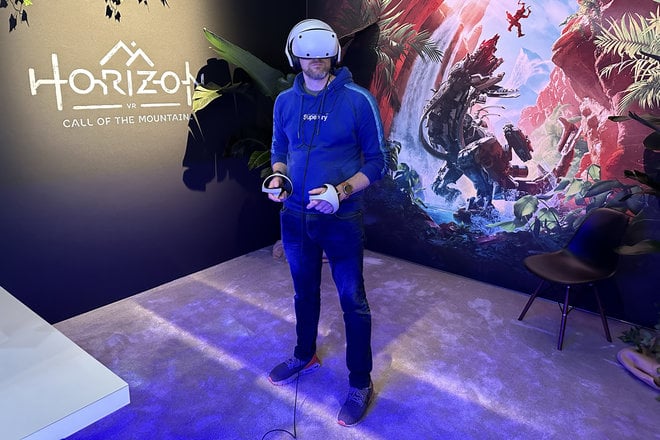
There are some technically difficult elements that Call of the Mountain tackles, like opening on a river, so having to deal with moving water. That’s no concern though, because there’s wonderful transparency and a really natural feeling to the environment you’re in.
Of course, you can look in any direction for a rewarding view and when you encounter the Broadhead, the scale is mind-blowing, not to mention the detail as it steps over you.
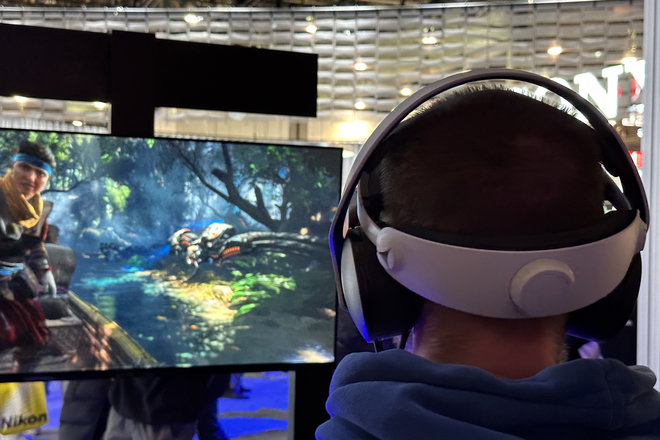
This is also paired with haptic feedback, both in the Sense controllers, but also through the headset itself. It’s surprisingly effective and while we can’t claim to have experienced the full range of uses for haptics, we’re already impressed at how they can improve the VR experience.
Front cameras for see-through
There are now cameras on the front of the PSVR 2 headset, meaning you can, at the press of a button, see the real world. This is a popular feature on VR headsets, so it’s great to see Sony also offer this.
However if there’s one early criticism of PSVR 2, its this see-through or passthrough system. Tap the button and you’ll get a black and white view of the world, which is pretty low quality.
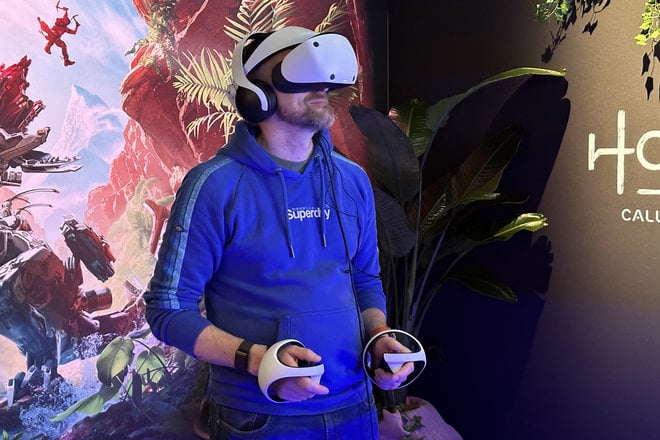
This is a long way from the performance you get from mixed reality headsets. Compared to the HTC Vive XR Elite – which we also demoed at CES 2023 – the PSVR 2 is no way near as good.
The question is, of course, how much you’ll actually need this feature. On the PSVR 2 it’s more of an occasional or emergency feature, while on the Vive XR Elite it’s a core function, hence the massive gulf in quality here.
